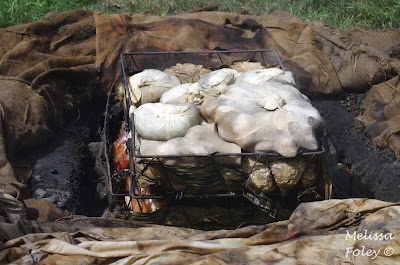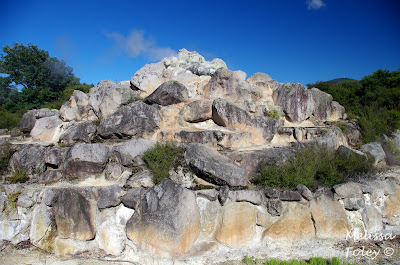Last week we had our first visitors that came to NZ exclusively to see us! My mom and cousin Jan ventured out from Minnesota for ten days of warm sunshine. They ended up only getting to enjoy nine days of summer thanks to wintry weather in Minneapolis the day they left. They missed their connecting flight in San Francisco and had to spend the night. The one upshot of the travel delay was they got to have dinner with Pete's parents. They arrived tired but in good spirits and ready for adventure.
I immediately whisked them off to the Tāwharanui Peninsula to meet our coworkers at a work retreat. We missed most of the festivities but arrived just in time for the main event...the hangi coming out of the ground! The hangi is the traditional Māori method of cooking food in the ground. I thought it would be a fun thing for my family to see and taste.
The food was put into the ground about four hours prior to digging it back out, and included lamb, chicken, and pork in the bottom basket, and potatoes, kumara (sweet potato-like), squash, cabbage, and stuffing in the top basket. The baskets are wrapped with wet cloth and then wet burlap before being covered with dirt. The food essentially gets steamed in the ground by the hot rocks that underlie the baskets of food. Everything is incredibly tender and pretty much falls apart with little encouragement when it comes out of the pit. There isn't a lot of seasoning that goes on the food, however, so it is a bit bland.
We sped through the gardens a bit faster than anticipated because we had an appointment at the kiwi house in the late afternoon. Seeing a kiwi in the wild is a difficult mission, but I wanted my mom and Jan to see the iconic critter while they were here. We went to Otorohanga Kiwi House, which completely exceeded my expectations. We arrived just in time for the kiwi feeding and got to see a very active great spotted kiwi, the only one on display in the world. We also got to see a couple of much more shy little brown kiwis foraging for food in their enclosure. Much like the Tasmanian devils, these kiwis are part of a breeding program. Most chicks are released into predator free areas where they will have a fighting chance of surviving and successfully producing babies.
The next stop on our tiki tour was the Waitomo area. Pete and I visited here in October and really loved it. Waterfalls, caves, natural bridges, glow worms...it pretty much has it all! I really enjoyed showing my family this place that is so different from Minnesota.
From the predator-free sanctuary, we continued east to Rotorua, a region known for its geothermal activity. Even if you cannot see the steam, the smell when you get out of the car is distinctive and permeates the air throughout the town. We ambled through a park near the center of Rotorua that features hot pools and mud pools, including a soaking tub for your feet.
Our final stop on our way home was at the Pukorokoro Miranda shorebird sanctuary (more birds, I know). This place is a stopover for many, many species of migrating birds from as far away as the Arctic. There are even birds from California that hang out here. It was still a couple hours from high tide so the birds were a bit far away. We could identify most through the binoculars, though, and noted pied stilts, pied oystercatchers, godwits, mallards, and plovers. There wasn't much activity while we were in the hide, but on our walk back to the car the godwits got stirred up and a flock of wrybills flew by.
I immediately whisked them off to the Tāwharanui Peninsula to meet our coworkers at a work retreat. We missed most of the festivities but arrived just in time for the main event...the hangi coming out of the ground! The hangi is the traditional Māori method of cooking food in the ground. I thought it would be a fun thing for my family to see and taste.
The food was put into the ground about four hours prior to digging it back out, and included lamb, chicken, and pork in the bottom basket, and potatoes, kumara (sweet potato-like), squash, cabbage, and stuffing in the top basket. The baskets are wrapped with wet cloth and then wet burlap before being covered with dirt. The food essentially gets steamed in the ground by the hot rocks that underlie the baskets of food. Everything is incredibly tender and pretty much falls apart with little encouragement when it comes out of the pit. There isn't a lot of seasoning that goes on the food, however, so it is a bit bland.
uncovered baskets - veggies on top and meat on the bottom
meat basket
Tāwharanui beach
The following day, the ladies headed south for a long weekend. Our first stop was Hamilton Gardens, a lovely oasis of themed gardens overlooking the Waikato River. The themed gardens range from Japanese to Tudor to Māori, with just about everything in between.
Indian Char Bagh garden
Italian Renaissance garden
We sped through the gardens a bit faster than anticipated because we had an appointment at the kiwi house in the late afternoon. Seeing a kiwi in the wild is a difficult mission, but I wanted my mom and Jan to see the iconic critter while they were here. We went to Otorohanga Kiwi House, which completely exceeded my expectations. We arrived just in time for the kiwi feeding and got to see a very active great spotted kiwi, the only one on display in the world. We also got to see a couple of much more shy little brown kiwis foraging for food in their enclosure. Much like the Tasmanian devils, these kiwis are part of a breeding program. Most chicks are released into predator free areas where they will have a fighting chance of surviving and successfully producing babies.
The next stop on our tiki tour was the Waitomo area. Pete and I visited here in October and really loved it. Waterfalls, caves, natural bridges, glow worms...it pretty much has it all! I really enjoyed showing my family this place that is so different from Minnesota.
Jan and Mama Foley at Marokopa Falls
inside Piripiri Cave
Mangapohue Natural Bridge
limestone gorge downstream of the natural bridge
our little fantail friend that followed us on our hike
natural tunnels through the limestone formations
NZ doesn't have a vast collection of charismatic megafauna. Our Australian neighbors took the monopoly on that one, while NZ focused on the birds. There are only two mammals native to NZ and both are bats. Today there are a few more present due to introductions, but they are mostly small - rats, stoats, and possums being three of the most infamous. There are some native birds in our urban Auckland environs, but the predator-free sanctuaries are the best places to see native birds. We visited Mangatautari (Sanctuary Mountain) to try to find some birds, particularly the kaka, a large, lowland parrot.
The forest at Mangatautari is a very mature forest, which is fabulous, but it makes the birds hard to see because they can be high up in the canopy. We enjoyed a lot of bird song and did manage to find a small group of kakas around one of the feeders. A hike up the tower gave us a birds-eye view into the canopy of the forest, as well as the numerous epiphytic plants that cling to many of the trees in the forest. On one tree we counted six different epiphyte species!
kākā
From the predator-free sanctuary, we continued east to Rotorua, a region known for its geothermal activity. Even if you cannot see the steam, the smell when you get out of the car is distinctive and permeates the air throughout the town. We ambled through a park near the center of Rotorua that features hot pools and mud pools, including a soaking tub for your feet.
stack of smoking rocks
boiling mud
very hot water - not for swimming!
it was a steamy walk!
We also visited the Whakarewarewa Māori village to see a cultural performance and learn about how they live in a geothermal area. Their village also has a vast array of hot pools and a few geysers. They use the hot pools for a number of things. They cook vegetables in one of the non-sulfur pools (about a minute for sweet corn) and use the boiling water from another pool to fill their communal baths. They use the steam rising out of the ground to cook meat and things not suitable for dangling in the hot water (the method is similar to the hangi described above but in a box instead of in the ground). The graves in the village (and throughout Rotorua) are all above ground because of the geothermal activity that is very close to the surface. In recent years, the village has been reduced in size because many houses were deemed to be sitting on unsafe ground. We saw the remnants of a few that had met their demise in a deep sink hole.
we heard an array of traditional songs
above ground graves
boiling pool - aka the vegetable cooking pot
the communal baths - they are filled with hot water from
a nearby pool every morning via the tracks in the rock
a nearby pool every morning via the tracks in the rock
pools throughout the village
the Pohutu geyser
carving on the meeting house
Saint Faith's church
From Rotorua, we headed north back to Auckland but made a couple stops along the way. The first was at Karangahake Gorge, an old gold mining area complete with swing bridges, tunnels, and old rail lines. The scenery was beautiful and we got to see a few glow worms in the tunnels. Yay!
crossing swing bridge #2
looking down the gorge from the mining tunnel
so many swing bridges!
old mining tunnel
another look down the gorge
Our final stop on our way home was at the Pukorokoro Miranda shorebird sanctuary (more birds, I know). This place is a stopover for many, many species of migrating birds from as far away as the Arctic. There are even birds from California that hang out here. It was still a couple hours from high tide so the birds were a bit far away. We could identify most through the binoculars, though, and noted pied stilts, pied oystercatchers, godwits, mallards, and plovers. There wasn't much activity while we were in the hide, but on our walk back to the car the godwits got stirred up and a flock of wrybills flew by.
godwits milling about
wrybills - the only birds to have a beak curved to the right
so many birds!!
Pete and I had to go to work for a couple days so my mom and Jan explored around our neighborhood and in central Auckland. Pete took them to the west coast to experience our black sand beaches and introduced them to the meat pie. On their last full day in NZ, we took a ferry to Devonport, a quaint little village across the harbour from central Auckland. We shopped for gifts, climbed a volcano for great views of the city, and enjoyed some delicious chocolate.
the view of Auckland from Mount Victoria
it may have been a tad windy...
We finished their visit with the Chinese lantern festival in Auckland. Just as we were leaving, the full moon rose over the museum...the best lantern of them all.
Thank you so much for coming to visit us! It was fun showing you our home and our new country. Come again any time!!








































No comments:
Post a Comment